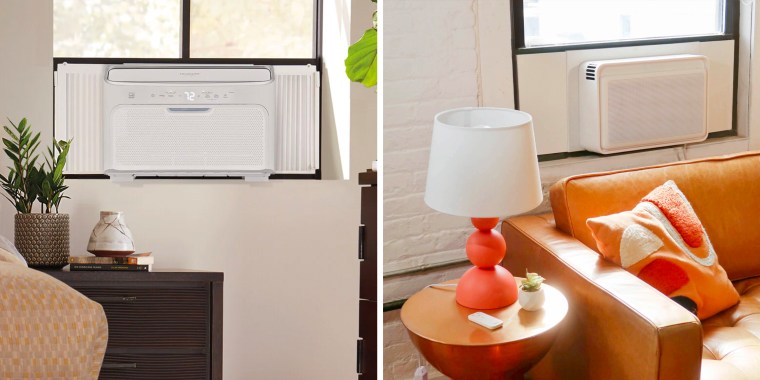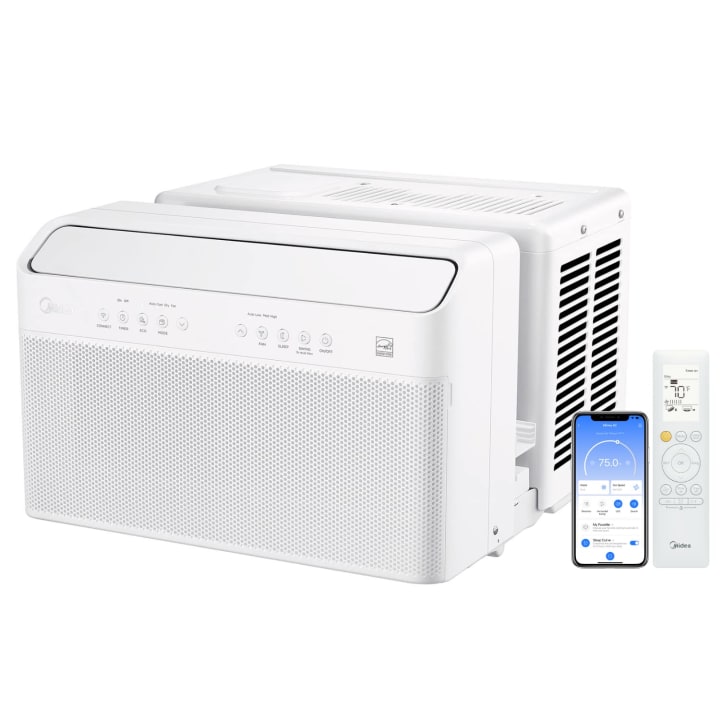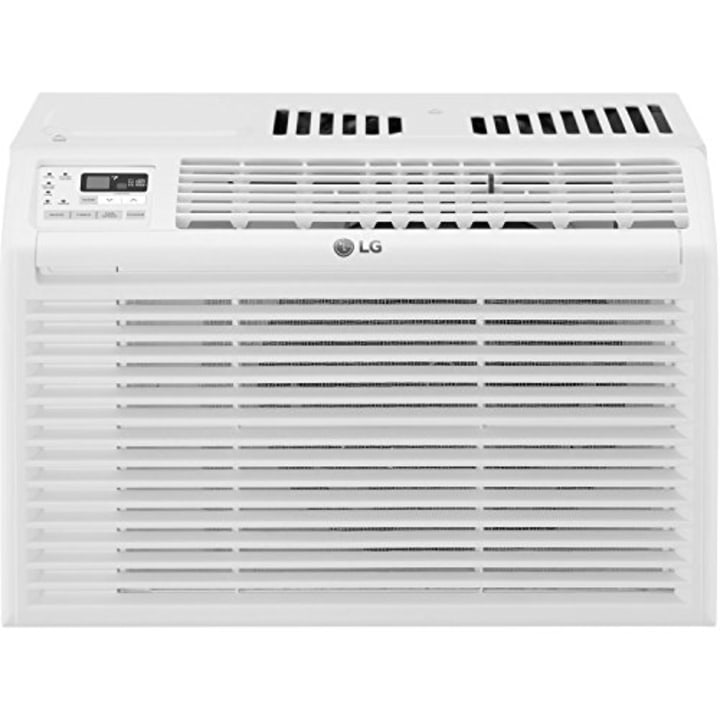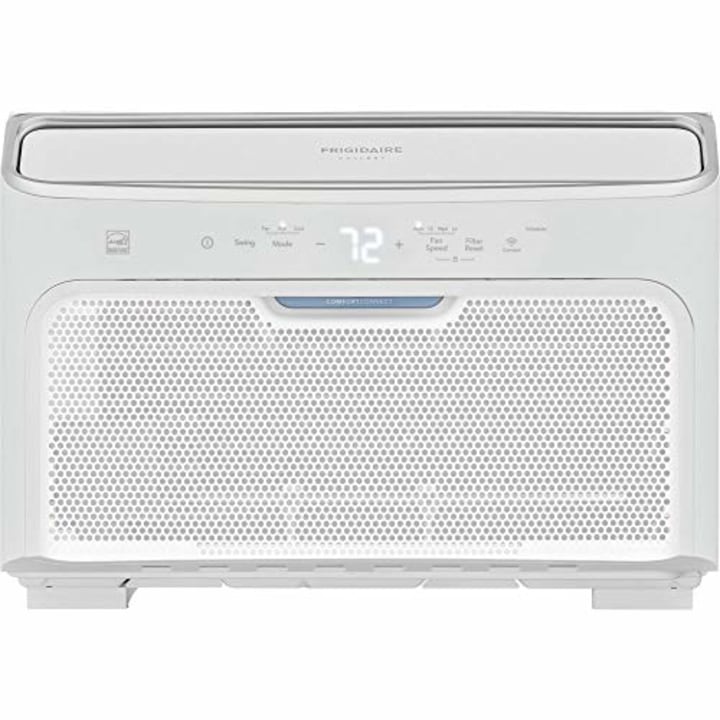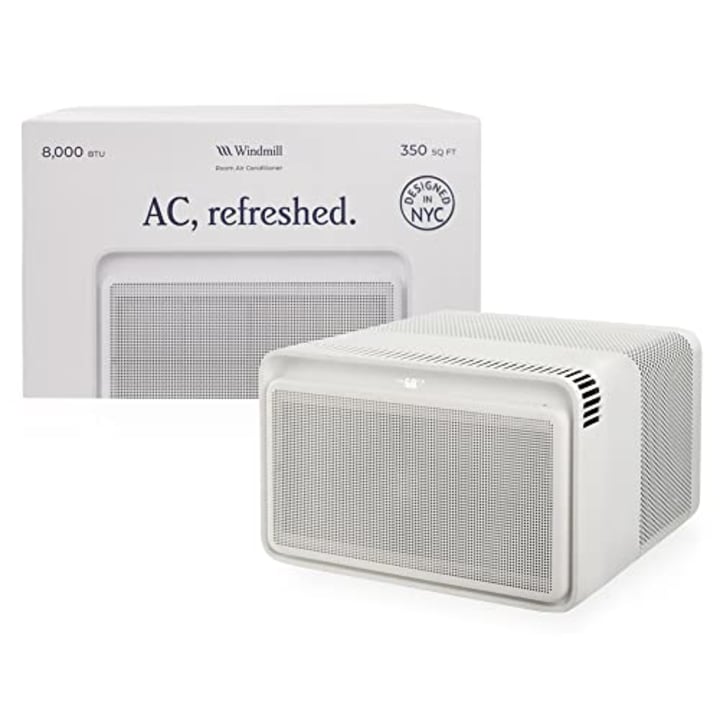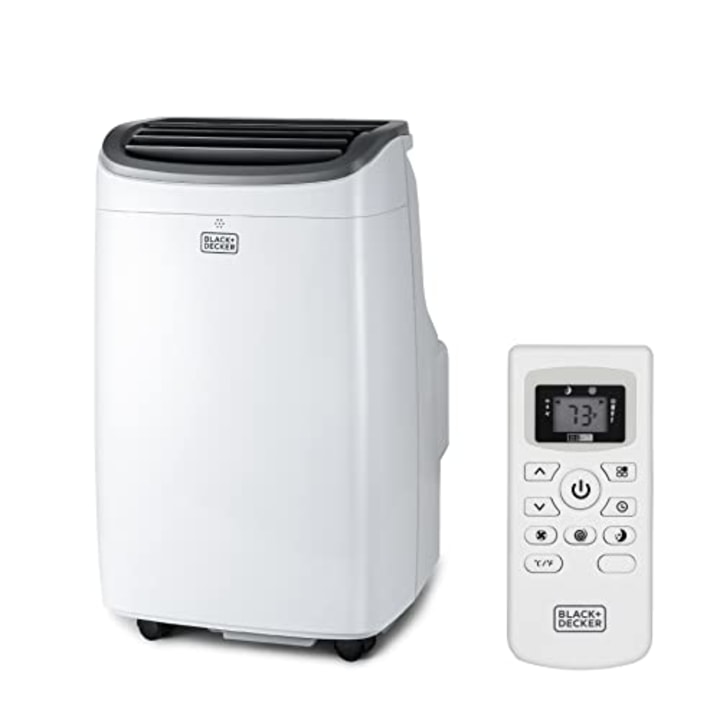Your air conditioner probably isn’t the prettiest appliance in your home, but it is one of the most important in the summer months. Whether you have a single window unit or multiple portable ones, an AC will keep your space cool and comfortable when the weather outside is anything but.
SKIP AHEAD Select staff’s favorite air conditioners | How to shop for an air conditioner | Can I use my AC if it’s smokey outside?
To help understand how to choose the best air conditioners for your space, we consulted appliance and energy experts on the features and specs to look for. We rounded up top-rated models based on their advice, including different types of ACs across a range of price points.
Our top picks
- Select pick: Midea U 8,000 BTU U-shaped inverter window AC
- Best looking: Windmill 8,000 BTU window AC
- Most affordable: Midea 5,000 BTU EasyCool window AC
How we picked our favorite air conditioners
The experts we spoke to helped us to understand better the more technical aspects of air conditioners, and how best to compare different units. Using their expertise as guidance, we selected air conditioners using the following criteria:
First-hand experience: We largely focused on air conditioners owned and loved by Select staff. For units we could not try ourselves, we only recommended top-rated options.
Top-rated: All of the AC units we recommend have at least a four-star average rating from customers on Amazon.
Room size: We picked air conditioners fit for different room sizes ranging from 150 to 450 square feet.
Select staff’s favorite air conditioners
Our top picks come from a mix of large appliance companies like LG and Frigidaire and newer brands like Windmill Air. With each recommendation, we’ve highlighted important details like cooling power, rated room size, dimensions and more.
Select Pick:
The Midea U window air conditioner is a favorite of former Select associate editor Justin Krajeski, who found it quiet, energy efficient and high-tech. It is designed in a U-shape that allows you to open and close your window even after the unit is installed. Krajeski also liked that this AC connects to Wi-Fi and can be controlled through the Midea Air app, Amazon Alexa and Google Home voice assistants.
Krajeski used the 8,000 BTU version, which is designed to cool rooms up to 350 square feet. The Midea U also comes in 10,000 BTU and 12,000 BTU versions, rated to cool 450- and 550-square-foot rooms respectively.
Type: Window, inverter | Cooling power: 8,000 BTUs | CEER: 15 | Room size: Up to 350 square feet | Energy Star: Yes | Controls: On-unit, remote, mobile app | Advertised noise level: 42dB | Weight: 55.6 lbs. | Dimensions: 19.17 D x 21.97 W x 13.46 inches
For small spaces:
For smaller spaces and smaller budgets, this window air conditioner from LG is recommended by Select associate updates editor Zoe Malin. She uses it in her kitchen, which is about 200 square feet. This LG model is one of the smaller and lighter air conditioners on our list. It comes with a wireless remote that can be used to control the unit from afar, but it doesn’t have a dedicated app.
One downside to this model is that it is noisier than others. “I don’t really mind it because I hate silence, so I almost see it as a noise machine,” says Malin. “But if you’re looking for something you can’t hear, look elsewhere.”
Type: Window, non-inverter | Cooling power: 6,000 BTUs | CEER: 11.3 | Room size: Up to 250 square feet | Energy Star: No | Controls: On-unit, remote | Advertised noise level: 52dB | Weight: 39.6 lbs. | Dimensions: 14.38 D x 17.31 W x 11.13 H inches
For large spaces:
I use a larger, discontinued Frigidaire Gallery AC to cool most of my apartment, specifically my living room, kitchen and hallway. Those three spaces only measure to about 200 square feet, but because the kitchen has heat-generating appliances like the oven and stove top, I bought this larger, more powerful unit. It works efficiently and effectively, keeping my space cool even while I’m cooking.
The newer model from Frigidaire is just as powerful but has more bells and whistles, including Wi-Fi connectivity, app control and an inverter design. According to our experts, inverter air conditioners are more energy efficient than non-inverters — you may save money on your energy bill with one.
This unit is the largest of our recommendations. Make sure to measure your window and windowsill clearance so you know if it will fit your space. There is also a smaller 8,000 BTU model as well as an even larger 12,000 BTU model, rated for 350 and 550 square foot rooms respectively.
Type: Window, inverter | Cooling power: 10,000 BTUs | CEER: 15 | Room size: Up to 450 square feet | Energy Star: Yes | Controls: On-unit, remote, mobile app | Advertised noise level: 42dB | Weight: 56 lbs. | Dimensions: 19.45 D x 23 W x 13.9 H inches
Best looking:
Let’s face it: Window-unit air conditioners aren’t the prettiest. The Windmill AC is one of the most aesthetically pleasing options though — that’s why Select editorial director Lauren Swanson bought one to cool her 250-square-foot living room. She found it easy to set up, install and control. You can operate the AC via the on-unit buttons, a wireless remote or your phone via the Windmill Air app. Swanson likes that she’s able to turn the unit on and off and change the temperature through the app when she’s away from her apartment.
This Windmill AC unit also comes in an inverter version that is quieter and more energy efficient, according to the brand.
Type: Window, non-inverter | Cooling power: 8,000 BTUs | CEER: 11.8 | Room size: Up to 350 square feet | Energy Star: Yes | Controls: On-unit, remote, mobile app | Advertised noise level: 50dB | Weight: 59 lbs. | Dimensions: 19.3 D x 19.4 W x 13.2 H inches
Most affordable:
If cost is your first priority, this top-rated window air conditioner from Midea is the lowest priced on our list. It is rated to cool a room size up to 150 square feet, making it well-suited for smaller spaces, such as bedrooms or home offices. You control the AC via the dials on the unit — it does not come with a remote that you can use to set it to a specific temperature like our other recommendations do.
According to data provided by the brand, this is the loudest air conditioner on our list. If you are sensitive to noise, it may be worth spending a little more on one of our quieter recommendations. The Midea EasyCool comes in a range of sizes, starting with this small 5,000 BTU model all the way up to a large 12,000 BTU unit.
Type: Window, non-inverter | Cooling power: 5,000 BTUs | CEER: 11 | Room size: Up to 150 square feet | Energy Star: No | Controls: On-unit | Advertised noise level: 57dB | Weight: 39 lbs. | Dimensions: 15.35 D x 15.98 W x 12.05 H inches
Top-rated portable air conditioner:
Portable air conditioners are typically easier to install than window units, and they are easier to store during cooler seasons. This unit from Black+Decker is one of our favorite portable air conditioners. It is rated for rooms up to 350 square feet, and it comes with both on-unit and a remote control to manage the temperature. It has four built-in caster wheels that allows you to move it from room to room.
Black + Decker makes a variety of models ranging from this 8,000 BTU version all the way up to a 14,000 BTU model that has both cooling and heating capabilities. On Amazon, it has a 4.3-star average rating from over 41,000 customer reviews.
Type: Portable | Cooling power: 8,000 BTUs | CEER: 5.4 | Room size: Up to 350 square feet | Energy Star: No | Controls: On-unit, remote | Advertised noise level: 54 dB | Weight: 52.9 lbs. | Dimensions: 15.3 D x 14 W x 24.8 H inches
How to shop for an air conditioner
Consumers have many choices when it comes to picking the right air conditioner for their home. Window units are the most popular among the Select team, and are “best when cooling a single area like a bedroom or large living space,” says Brice Bowley, senior director of air conditioner technology at GE Appliances.
For larger homes with multiple rooms or floors, “it may be cheaper and more energy efficient to choose a central or multi-split cooling system like central air conditioning or a heat pump,” says Leslie Jones, media and public affairs specialist for Energy Star labeled products.
Regardless of your space, there are a few key terms and labels to understand in order to purchase the best, most efficient air conditioner possible, according to our experts.
BTUs (British Thermal Units)
An air conditioner's cooling power is measured in BTUs, or British Thermal Units. The higher a unit’s BTU rating, the larger a space it can cool.
Below is a breakdown of the number of BTUs needed to cool different-sized spaces, according to Jones and Energy Star:
Up to 250 square feet: 5,000 to 6,000 BTUs
From 250 up to 350 square feet: 7,000 to 8,000 BTUs
From 350 up to 450 square feet: 9,000 to 10,000 BTUs
From 450 up to 550 square feet: 12,000 BTUs
From 550 up to 700 square feet: 14,000 BTUs
Your room’s square footage isn’t the only number to think about when assessing how powerful an AC unit you’ll need, according to Energy Star. If the space is heavily shaded, you need 10% less BTUs. A very sunny room, meanwhile, needs 10% more BTUs. Any AC unit used in a kitchen should have an extra 4,000 BTUs to counteract heat-generating appliances.
CEER (Combined Energy Efficiency Ratio)
CEER stands for combined energy efficiency ratio. It is “the ratio of measured cooling output (in BTU per hour) to measured average electrical energy input (in Watts) and measured standby/off-mode power consumption (in Watts),” says Jones.
Essentially, it is one way to measure how efficient an air conditioning unit is. A unit with a higher CEER is more energy efficient than a unit with a lower CEER.
For window-unit ACs, you’ll typically see a CEER between 11 and 15. Since 2014, all window units with a BTU rating under 8,000 must operate at a minimum CEER of 11, following standards put in place by the U.S. Department of Energy (DOE). This standard is currently being updated: By 2026, the minimum CEER for similar products will be 12.8. For window units with a BTU rating above 8,000, the DOE is pushing for an even higher CEER, and encouraging manufacturers to use inverter technology to get there.
Per FTC guidelines, all window ACs are “required to have an energy guide which displays the CEER value,” says Bowley.
Portable AC units are less energy efficient, so it’s more common to see CEER scores ranging from five to nine.
Look for an AC that uses inverter technology
Most older or smaller ACs are non-inverter units. Non-inverter units use a simple compressor that is either 100% on, trying to cool your space to the temperature you set, or 100% off, having reached the desired temperature.
Inverter ACs have a variable speed compressor to more efficiently maintain the temperature you set. Instead of running at full-blast or completely turning off, an inverter AC will run faster or slower depending on the needs of the space, similar to a car using cruise control to maintain a certain speed, says Jones.
Inverter ACs tend to be more energy efficient and have a higher CEER than non-inverter ACs. They are usually more expensive to purchase than non-inverter ACs but can save you money in the long run with lower energy bills.
Look for an Energy Star certified AC
Energy Star is a program within the U.S. Environmental Protection Agency (EPA) and U.S. Department of Energy (DOE) that promotes energy efficiency in a broad range of appliances. Products that earn an Energy Star symbol are “independently certified to help consumers to save energy and money while protecting the environment,” says Jones.
For a window AC unit to meet Energy Star certified requirements, “it must be at least 10% more efficient than the federal minimum for this product type, and meet other requirements outlined in the most recent Energy Star product specification,” says Jones.
You can verify a product is Energy Star certified through Energy Star’s online product finder tool.
Can I use my AC if it’s smokey outside?
The air quality outside can shift dramatically during certain weather patterns or natural disasters like wildfires. Poor air quality can cause irritation, trigger allergic reactions and lead to long-term health problems, according to the EPA.
Certain types of air conditioners should not be used if there is heavy smoke outside. If you have a window unit, you can still use it if the air damper is closed. Just make sure the seal between the air conditioner and the window is as airtight as possible, says Jones.
Do not use single hose portable air conditioners if there is heavy smoke outside, as these will potentially bring smoke into your space. Dual hose portable air conditioners can be used, but monitor them carefully and make sure the seal between the window vent kit and window is airtight, says Jones.
Meet our experts
At NBC Select, we work with experts who have specialized knowledge and authority based on relevant training and/or experience. We also take steps to ensure all expert advice and recommendations are made independently and without undisclosed financial conflicts of interest.
Brice Bowley is the senior director of air conditioner technology at GE Appliances.
Leslie Jones is the senior media and public affairs specialist for Energy Star labeled products at the U.S. Environmental Protection Agency (EPA).
Why trust NBC Select?
Harry Rabinowitz is a reporter at NBC Select who has covered consumer technology for years. For this piece, he interviewed appliance and energy experts to better understand air conditioners and their most important specifications. He leveraged his personal experience and the experience of Select staff members to help select recommended products. He also conducted thorough research of other top-rated air conditioners.
Catch up on Select’s in-depth coverage of personal finance, tech and tools, wellness and more, and follow us on Facebook, Instagram, Twitter and TikTok to stay up to date.
